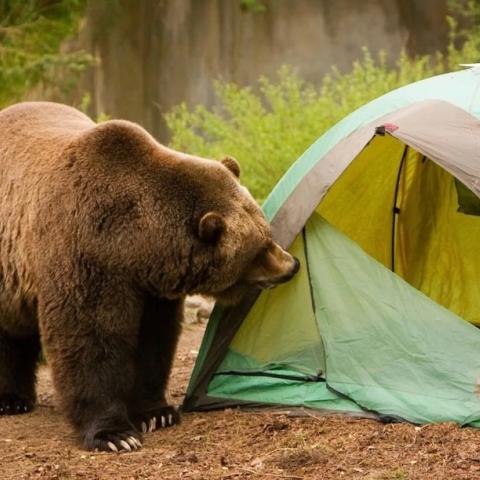An annual elk hunt intended to keep the overall population in check begins this weekend at Grand Teton National Park, though likely not without controversy.
The hunt is called for in the park's enabling legislation, passed by Congress in 1950. That legislation directs Grand Teton National Park to jointly develop the hunt with the Wyoming Game and Fish Department, and for the governor of Wyoming and Interior secretary to approve the annual plan. Respective federal and state biologists and administrators have reviewed available biological data and concluded that the 2015 program is necessary for the proper management and protection of the elk, including keeping the herd at or near the population objective.
Earlier this year the National Park Service, Interior Department, and U.S. Fish and Wildlife Service were sued by the Sierra Club and Western Watersheds Project because the Fish and Wildlife Service had decided that the region's grizzly bear population would be able to withstand the loss of four bears killed over seven years in connection with the elk hunt.
“Authorizing the killing of four grizzly bears in a national park is not good management for grizzlies or national parks,” Earthjustice attorney Tim Preso said when the lawsuit was filed in April. “The government should be working to eliminate grizzly mortality threats, not handing out authorizations to kill grizzly bears in one of our nation’s premiere national parks.”
And it was a year ago when a Wyoming-based media outlet reported that federal wildlife authorities expect more grizzlies to be killed by hunters than initially thought.
In November 2012, three elk hunters in the park shot and killed a grizzly that charged within ten feet of them. An investigation later absolved the hunters, saying they acted in self-defense.
For this year's hunt, the areas open to the program, Wyoming Game and Fish Department Elk Hunt Areas 75 and 79, are generally located on the east side of the park, and north of the Gros Ventre River, according to park staff. The Snake River Bottom, between Deadman’s Bar access road to Ditch Creek west of US Highway 26/89/191, is closed to the program. The Antelope Flats area is closed to the program after November 30, and the entire program ends December 13. The areas remain open to park visitors, and the wearing of orange or other bright colors is highly recommended during this time.
Grand Teton staff say the elk reduction program "is an important management tool that differs somewhat from other elk hunting programs in the region. Participants in the program must carry appropriate state license, conservation stamp and permits, use non-lead ammunition, and are limited in the number of cartridges they are able to carry each day. The use of archery, hand guns, or other non-center fire ammunition rifles is not permitted, nor is the use of artificial elk calls. In addition, participants, regardless of age, are required to carry a certified hunter safety card, wear fluorescent orange and carry and have immediately accessible bear spray as a non-lethal deterrent for use during potential bear encounters. Information packets accompanying each permit warn participants of the risk of bear encounters and offer tips on how to minimize the probability of human-bear conflicts."
The need for this reduction program, according to park officials, "stems partly from an intensive management framework that includes annual winter feeding programs on the National Elk Refuge and in the upper Gros Ventre Drainage. Feeding sustains high numbers of elk with unnaturally low mortality rates. A majority of elk that are fed during the winter on the refuge also summer in Grand Teton National Park or use migration routes across park lands. The reduction program targets elk from three primary herd segments: Grand Teton, southern Yellowstone National Park, and the Teton Wilderness area of Bridger-Teton National Forest."
Park rangers will monitor and patrol elk reduction areas to ensure compliance with rules and regulations, interpret the elk reduction program to visitors, and provide participants with information on local conditions associated with this wildlife management program.
An information line for the 2015 elk reduction program is available at 307-739-3681. A brochure on elk ecology and a map showing locations open to these special permit hunters is available online.




 Support Essential Coverage of Essential Places
Support Essential Coverage of Essential Places







Comments
The people who hate the Park Hunt will ALWAYS go directly to starving the elk to death/end feeding to stop the hunt. Because they KNOW that the hunt will end if the feeding does. They would rather see elk starve to death than be hunted where the elk have always been hunted. Any arguement that "they didn't used to be fed" is ludicrous as the town of Jackson and everything around it didn't exist before the feeding started. Go look at the pictures from 100 years ago with elk carcasses littering the landscape. It will repeat.
Sounds like a matter of carrying capacity and development. That said, Yellowstone's bears once relied on garbage dumps. Once that practice ended the landscape wasn't littered with bear carcasses.
As for possible solutions and impacts of closing the elk feeding grounds, the Wyoming Wildlife Advocates had some interesting ideas:
http://wyomingwildlifeadvocates.org/dashboard/wp-content/uploads/2014/11...
Kurt you provide a link to a group who is openly doing whatever they can to stop the GTNP elk hunt. Why should anyone look at what they put out as unbiased????
Well, one could say that knife cuts two ways...
That said, the paper does cite articles from the Journal of Wildlife Management, the Wyoming Outdoor Council, the Bureau of Land Management, the Bridger-Teton National Forest, The Wildlife Professional, as well as the USFWS and NPS.
Please offer any countering materials.
This.
http://www.nps.gov/grte/learn/management/upload/Grand-Teton-NP-enabling-...
Is the reason anti-hunters are trying so desperately to lower the elk population through starvation. They would sacrifice thousands of elk to stop the GTNP hunt.
I don't have anything against the hunt if needed, but I'm not sure who are the advocates for the feeding?
http://www.jhnewsandguide.com/opinion/columnists/the_new_west_todd_wilki...